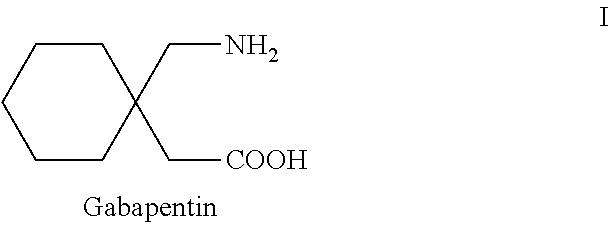Process for the preparation of gabapentin
a gabapentin and process technology, applied in the field of process for the preparation of gabapentin, can solve the problems of inability to give experimental details for reactions, cumbersome process, and difficult process
- Summary
- Abstract
- Description
- Claims
- Application Information
AI Technical Summary
Benefits of technology
Problems solved by technology
Method used
Image
Examples
example 1
on of Spiro [cyclohexane-1, 9′-(3, 7-diazabicyclo-[3.3.1] nonane)]-2′, 4′, 6′,8′-tetraone (VI)
[0041]120 mL of 60% solution of sulphuric acid was heated to 70°-75° C. and to this solution was added 2, 4-dioxo-3-aza-spiro [5.5] undecane-1, 5-dicarbonitrile (V) (30.0 g, 0.129 moles) slowly. After the addition, the reaction mixture was heated to 100° C.-105° C. and maintained at this temperature for 22 hours. The reaction mixture was cooled, diluted with 180 mL water and stirred for 1 hour. The solids were filtered, washed with water and dried at 60° C. for 5 hours to obtain spiro[cyclohexane-1, 9′-(3, 7-diazabicycle-[3.3.1] nonane)]-2′, 4′, 6′, 8′-tetraone (VI), 27 g (Yield: 83.3%). Melting Range (DSC): 406.88-410.96° C. (Lit: 400-405° C.; J. Chem. Soc., 1911, 99, 422-448). IR(KBr): 3209, 3097 (—NH stretch), 2948, 2850 (C—H Stretch, 1708 (C═O), 1425& 1363 cm−1. 1H NMR (300 MHz, DMSO): δ 11.67 (s, 2H, —NH), 3.75 (s, 2H) & 1.39-1.48 (m, 10H, cyclohexyl group). 13C NMR (75 MHz, DMSO): δ 1...
example 2
on of Spiro [cyclohexane-1, 9′-(3, 7-diazabicyclo-[3.3.1] nonane)]-2′, 4′, 6′, 8′-tetraone (VI)
[0042]Experiment was conducted as described in Example 1, but instead of using 60% solution of sulphuric acid, 70% solution of sulphuric acid was used. Yield: 78.7%, HPLC: 96.8%.
example 3
on of Spiro [cyclohexane-1, 9′-(3, 7-diazabicyclo-[3.3.1] nonane)]-2′, 4′, 6′, 8′-tetraone (VI)
[0043]Experiment was conducted as described in Example 1, but instead of carrying out the reaction at 100° to 105° C., the reaction was carried out at 90° to 95° C. Yield: 77.1%, HPLC: 98.27%.
PUM
| Property | Measurement | Unit |
|---|---|---|
| Temperature | aaaaa | aaaaa |
| Temperature | aaaaa | aaaaa |
| Fraction | aaaaa | aaaaa |
Abstract
Description
Claims
Application Information
 Login to View More
Login to View More - R&D
- Intellectual Property
- Life Sciences
- Materials
- Tech Scout
- Unparalleled Data Quality
- Higher Quality Content
- 60% Fewer Hallucinations
Browse by: Latest US Patents, China's latest patents, Technical Efficacy Thesaurus, Application Domain, Technology Topic, Popular Technical Reports.
© 2025 PatSnap. All rights reserved.Legal|Privacy policy|Modern Slavery Act Transparency Statement|Sitemap|About US| Contact US: help@patsnap.com



